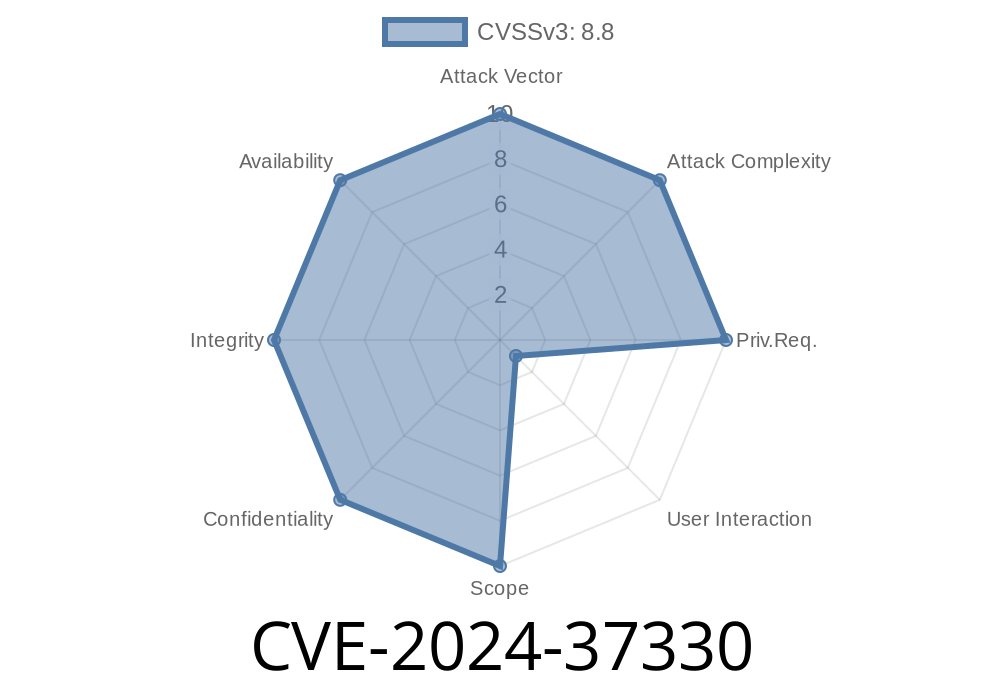In June 2024, Microsoft published a high-severity security advisory for CVE-2024-37330, a Remote Code Execution (RCE) vulnerability targeting the SQL Server Native Client (SNAC) OLE DB provider. This advisory has gotten a lot of attention from security researchers and system administrators alike, especially for those organizations running apps that connect to SQL Server through OLE DB.
This post explains what CVE-2024-37330 is, how attackers can exploit it, the risk it poses, and what you should do to stay safe. We'll also provide simple code snippets and direct references to help you understand and mitigate the threat.
What Is CVE-2024-37330?
CVE-2024-37330 is a vulnerability found in the SQL Server Native Client OLE DB provider. This is a Microsoft component that allows applications or scripts to interact with SQL Server databases using OLE DB interfaces.
A remote attacker can exploit this vulnerability to run any code of their choice on the affected system, with the permissions of the process using the OLE DB provider. In other words, if your Windows app connects to SQL Server using SNAC OLE DB, and an attacker can get you to run malicious data through it, they could take control of your system.
Microsoft Security Guide:
- CVE-2024-37330 | SQL Server Native Client OLE DB Provider Remote Code Execution Vulnerability
NIST National Vulnerability Database:
- https://nvd.nist.gov/vuln/detail/CVE-2024-37330
Normally, when your application runs this sort of standard code
using System.Data.OleDb;
string connStr = "Provider=SQLNCLI11;Server=MyServer;Database=TestDB;Uid=sa;Pwd=password;";
using (OleDbConnection conn = new OleDbConnection(connStr))
{
conn.Open();
// Your queries here
}
Everything seems safe—as long as you trust what’s being sent to the server. But CVE-2024-37330 is about a flaw inside the Native Client OLE DB provider itself. If an attacker can trick your application into using a specially crafted connection string or data payload, the vulnerable provider may execute arbitrary code.
Suppose a web app accepts user input and uses it unsafely
string userInput = GetUserInput();
string connStr = $"Provider=SQLNCLI11;Server={userInput};Database=TestDB;Uid=sa;Pwd=password;";
using (OleDbConnection conn = new OleDbConnection(connStr))
{
conn.Open();
}
If the attacker sends a malicious payload as userInput, it can exploit the underlying bug in the OLE DB provider’s code, potentially leading to remote code execution on the server running this code.
Key points
- The vulnerability depends on parsing certain fields in the connection or query, triggering a bug in the OLE DB provider.
Proof-of-Concept (PoC) Snippet
*Note: For security reasons, this is a theoretical demonstration and not a live exploit.*
// Attacker-supplied data (e.g., as a 'Server' or 'Database' name)
string maliciousInput = "malicious.host;SomeExploitCodeHere";
string connStr = $"Provider=SQLNCLI11;Server={maliciousInput};Database=TestDB;Uid=sa;Pwd=password;";
using (OleDbConnection conn = new OleDbConnection(connStr))
{
conn.Open(); // Can crash, result in shellcode execution, or corrupt memory
}
This payload triggers the bug if the OLE DB provider parses the input incorrectly and leads to command injection or similar RCE.
Risk: Attackers can take full control of the server process running the vulnerable OLE DB code.
- Scope: Any Windows application using the SQL Server Native Client OLE DB that takes user-supplied or untrusted values is at risk.
You are affected if you
- Run Windows applications or websites that use *SQLNCLI* or *SQLNCLI11* (or older SNAC versions) and let users influence connection properties.
Patch Immediately
- Apply all updates listed in Microsoft's CVE-2024-37330 advisory.
Audit Your Code
- Make sure user input is never sent directly as part of connection strings, provider settings, or commands.
References
- Microsoft Security Advisory (Official)
- NVD Entry for CVE-2024-37330
- MS Docs: SQL Server Native Client (SNAC)
- General Overview of OLE DB Attacks (2019 BlackHat)
Conclusion
CVE-2024-37330 is a critical reminder of the risks in database driver and provider chains—even for trusted software components maintained by Microsoft. If you use the SQL Server Native Client OLE DB provider, patch your systems without delay and audit any code that lets users provide or influence database connection details.
Stay secure by staying informed—follow security advisories for your application stack, not just the OS!
*If you need help checking your systems or have questions, leave a comment below or check the links provided for more guidance.*
Timeline
Published on: 07/09/2024 17:15:21 UTC
Last modified on: 08/20/2024 15:48:22 UTC
